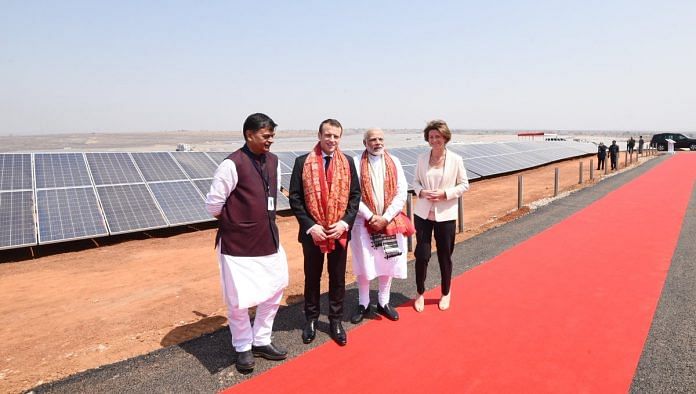PM Modi wants India to have 100 GW installed solar capacity by 2022, but panel says at the current rate, the target seems almost impossible to achieve.
New Delhi: Prime Minister Narendra Modi’s ambitious target of achieving 100 gigawatts of installed solar energy capacity by 2022 has received a setback, with the parliamentary standing committee on energy expressing disappointment with the government’s performance in the sector so far. The committee feels that at the current rate, the target will be very difficult to achieve.
“The committee observes that for the year 2017-18, against the target of 10,000 MW of grid-connected solar power, the ministry (of new & renewable energy) has been able to achieve only 6166.15 MW (as on 31 January 2018) with utilisation of Rs 951.93 crore,” it said in a report tabled in the Lok Sabha.
“The achievement is about 40 per cent short of the target. For the year 2018-19, a physical target of 11,000 MW for grid-connected solar power has been planned with an allocation of Rs 2045.25 crore.”
The standing committee also expressed concern over the ministry’s failure to achieve yearly targets. It said the government should have installed 32 GW of solar capacity by 2017-18. However, only 18.45 GW has been installed as of 31 January.
At the recent International Solar Alliance summit in New Delhi, Modi had reiterated India’s pledge to generate 175 GW of electricity from renewable energy sources by 2022, out of which 100 GW is to come from solar.
Roof-top troubles
In the roof-top solar segment, the committee is disappointed that only 953 MW of capacity has been installed, with the target for 2022 being 40 GW.
“The committee feels that roof-top systems are not remunerative for the consumers due to high maintenance cost and delay in disbursement of subsidy…given the performance of the ministry in this sector till date, the roof-top solar target of 40 GW by 2022 is unrealistic,” the report stated.
Safeguard duty
A safeguard duty of 70 per cent has been proposed on the import of solar cells from China and Malaysia, because India’s domestic industry has been operating far below its installed capacity, leading to issues like declining productivity per employee, increased inventories, and loss of potential employment opportunities.
On the issue of the duty, the committee felt that though project developers would suffer, it could be good for domestic manufacturers. However, it warned that such a duty would result in a steep rise in input cost, thereby affecting the viability of existing projects and dampening investors’ sentiments.
The committee agreed that there was a need to encourage domestic manufacturing, but it said it was hard to believe that domestic manufacturing would reach the production and efficiency level required to meet the 100 GW target.
Effect of GST on solar industry
Solar panels currently attract a GST of 5 per cent. However, there is confusion on the GST rates on other components — inverters attract 18 per cent GST, while batteries are taxed at 28 per cent.
Taking note of this, the committee said this confusion, as well as the uncertainty over the refund of input tax credit, was not healthy for the renewable energy sector.
Underutilisation of funds
The committee observed that for the last two years, the ministry had not been able to fully utilise the funds allocated to it — in 2015-16, 2016-17 and 2017-18 (up to December 2017), the ministry had only utilized 63, 65 and 70 per cent of funds respectively.
“The committee feels that given the ambitious targets to be achieved by the ministry, such low utilisation of allocated funds is beyond comprehension, and is indicative of poor financial planning by the ministry leading to suboptimal fund utilisation,” the report stated.
Under-funding of green energy corridor
The green energy corridor plan was launched to strengthen India’s intra-state and inter-state transmission of renewable energy like wind and solar.
The government had allocated Rs 500 crore for a target of installing 350 circuit km of transmission equipment in 2017-18. However, in the 2018-19 budget, for a target of 1,900 circuit km, the government has allocated only Rs 600 crore.
“The committee feels that there is mismatch between the fund allocated and physical targets set,” it pointed out.



